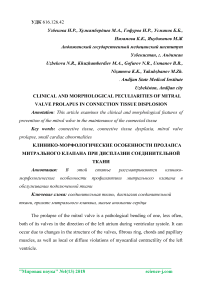Clinical and morphological peculiarities of mitral valve prolapus in connection tissue displosion
Автор: Uzbekova N.R., Khuzhamberdiev M.A., Gofurov N.R., Usmanov B.B., Nizamova K.K., Yakubzhanov M.Zh.
Журнал: Мировая наука @science-j
Рубрика: Основной раздел
Статья в выпуске: 4 (13), 2018 года.
Бесплатный доступ
This article examines the clinical and morphological features of prevention of the mitral valve in the maintenance of the connected tissue
Connective tissue, connective tissue dysplasia, mitral valve prolapse, small cardiac abnormalities, ziegler d, et al. exp.clin.endocrinol diabetes.-2009.-vol.107.-p.421-4
Короткий адрес: https://sciup.org/140263484
IDR: 140263484
Текст научной статьи Clinical and morphological peculiarities of mitral valve prolapus in connection tissue displosion
The prolapse of the mitral valve is a pathological bending of one, less often, both of its valves in the direction of the left atrium during ventricular systole. It can occur due to changes in the structure of the valves, fibrous ring, chords and papillary muscles, as well as local or diffuse violations of myocardial contractility of the left ventricle.
The mitral valve (bivalve) is located on the border of the left atrium and ventricle and under physiological conditions effectively blocks the reverse flow of blood. In the systole, the front and back flaps are closed. In this case, the front flap is bent in the direction of the venous ring, and the wide posterior wing closes the atrioventricular opening. The mobility of the valves during the course of the blood flow is limited by the length of the tendon chords that are attached to their thickened free margin, as well as papillary muscles that have elasticity and elasticity at the same time. During diastole the valves block the aortic opening at the interventricular septum, adjacent to the walls of the ventricle. The oval of the valve has an area of 11.8-13.12 cm 2, a longitudinal diameter of 1.7-4.6 cm, a transverse diameter of 1.73.3 cm. The circumference of the left atrioventricular aperture in the area of attachment of the valves to the fibrous ring is 6-9 cm at a young age, often increases with age to 12-15 cm. The average statistics for men are slightly larger than for women.
The prolapse of the mitral valve occurs in patients of different ages, more often in children than in adults and in women compared to men.
There are primary and secondary forms of the disease. Primary (idiopathic) prolapse, when pathology arises independently and is not associated with any disease or malformation. The secondary develops as a consequence of another disease.
Idiopathic prolapse is genetically conditioned and is formed due to congenital fibrillogenesis and myxomatous degeneration of the valves. At the same time, the middle layer of the sagging leaf significantly thickens due to disturbances in the structure of collagen fibers: an increase in acidic glycosaminoglycans occurs. Damage can spread to the tendon chords and fibrous valve ring, which often causes their rupture. As a consequence, the aggravation of mitral insufficiency and the movement of blood in the direction opposite to the physiological one. In addition, the sites of the altered endothelium can become zones of formation of endocarditis and thrombi.
Secondary prolapse of the mitral valve develops under various pathological conditions, the list of which is quite large. It often occurs with hereditary diseases of connective tissue, ischemic heart disease, hypertrophic obstructive cardiomyopathy, vegetative vascular dystonia, atrial septal defect, rheumatic fever. It is often combined with the syndrome of premature ventricular arousal. Characteristic is the dominance of the sympathetic tone of the autonomic nervous system over the tone of the parasympathetic and the increase in the amplitude of the heart contractions with an increase in the shock volume of the blood. The described changes promote strengthening of motor function of walls of a left ventricle and an interventricular septum. Against the background of which there is a decrease in filling with his blood due to tachycardia. Accordingly, during systole conditions are formed for the convergence of the walls of the left ventricle and valvular flaps, the tension of the chords is weakened, which contributes to prolapse.
Symptoms of mitral valve prolapse
In most patients it is asymptomatic and is often detected by chance, for example, during a routine preventive medical examination.
To the subjective manifestations can be attributed complaints of a neurogenic nature, associated primarily with vegetovascular dystonia and asthenic syndrome:
-
• General weakness;
-
• Decreased efficiency;
-
• Poor tolerance of physical activity;
-
• Unrestrained headaches;
-
• Dizziness;
-
• Propensity to develop short-term syncope;
-
• Feeling of lack of air.
Attach also cardiac complaints:
-
• Pain in the heart;
-
• Attack palpitations (with loads and often at rest);
-
• Feeling of irregularities in the heart, which is due to extrasystole;
-
• Shortness of breath;
-
• Rapid fatigue with physical activity, even moderate.
The leading and most frequent complaint of patients is a syndrome of cardialgia: constant pain in the region of the heart, usually stitching, aching, or contracting, not aggravated by physical exertion.It should be borne in mind that the nature of pain in expressing prolapse is directly related to concomitant diseases of the cardiovascular system. For example, with ischemic heart disease, the pain is anginal; at an inflection of a coronary artery can be paroxysmal, compressing and provoked by physical activity.


